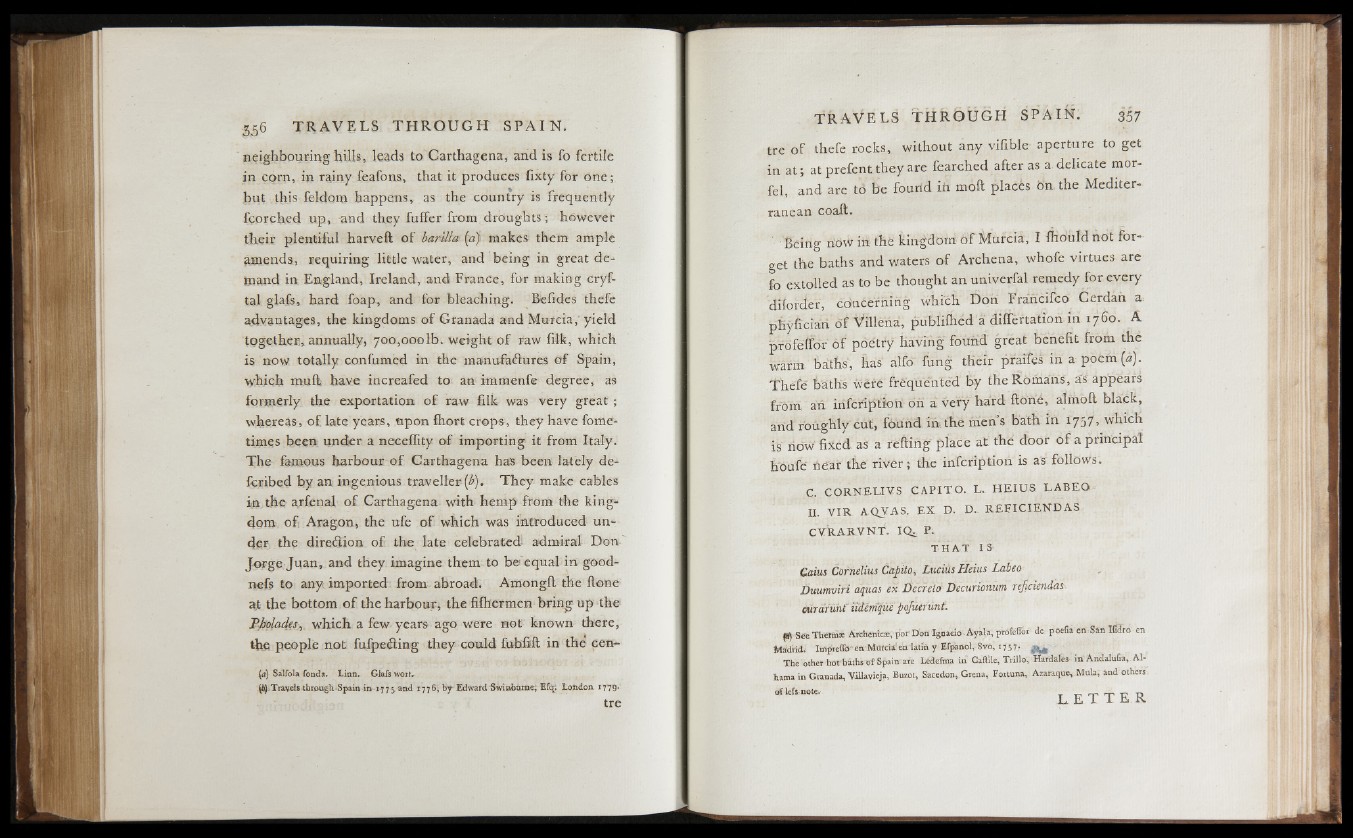
neighbouring hills, leads to Carthagena, and is To fertile
in corn, in rainy feafons, that it produces fixty for one;
hut this feldom happens, as the country is frequently
fcorched up, -and they fuffer from droughts; however
their plentiful harveft of barilla (a) makes them ample
amends, requiring little water, and being in great demand
in England, Ireland, and France, for making cryf-
tal glafs, hard foap, and for bleaching. Beiides thefe
advantages, the kingdoms of Granada and Murcia,'yield
together, annually, 700,0001b. weight of raw filk, which
is now totally confumed in the manufactures of Spain,
which muft have increafed to an immenfe degree, as
formerly the exportation of raw filk was very great ;
whereas, of late years, upon fhort crops, they have fome-
times been under a neceffity of importing it from Italy.
The famous harbour o f Carthagena has been lately de-
fcribed by an. ingenious traveller [b). They make cables
in the arfenal of Carthagena- with hemp from the kingdom
o f Aragon, the ufe o f which was introduced under
the diredion of the late celebrated; admiral Don
Jorge Juan, and they imagine them to be1 equal in good-
nefs to any< imported from abroad. Amongil the Hone
at the bottom, o f the harbour, the fifhermen bring up the
Pfoplacles, which a few years ago were not known there,
the people not fufpeding they could fufafift in the Gen-
[a) Salfola fonda. Linn. Glafs wort»
j$)Travds through-Spain in-1775 and 1 776, by Edward Swiabfcme; Eftjf London 1779*
tre
tre of thefe rocks, without any vifible- aperture to get
in at; at prefent they are fearched after as a delicate mor-
fel, and are to be fourid iri. moil placés b’n. the Mediterranean
coaft.
Being rioW in the kingdom o f Murcia, I fhould not forget
the baths and waters o f Archena, whofe virtues are
fo extolled as to be thought an univerfal remedy for every
dilorcier, concerning which Don Fraricifco Cerdah 3
p h ÿ f i c i a r i of Villënà, pübliihed â differtatioh in 1760. A
proleffor 6f poetry having found great benefit from the
¡ ¡ P baths', has alfo fun g their praifés in a p6èm («).
Thefé baths wèré frequented by the Romans, as" appears
from an infeription on a very hard Hone, alinôil black,
arid roughly cut, found in the men’s bath in 1757, which
is rio'w fiked as a refting place at thé door o f a principal
hbufe near the river; the infeription is as follows.
C. CORNE L IVS C API TO. L. H E IU S L A B E O
II. V IR A-QVAS. EX D. D. REFI .CIENDAS
C V R A R V N T . IQ j P.
T H A T I S
Caius Cornelius Capita, Lucius Heius Labea
Duumviri aquas ex Décrété Decurionum reficiendas-
cûràrûht' iidémquè pajüerunt
ftj See Therfnzc Arehenicæ, por Don Ignacio-Ayala, pfoféflôr de poefià enSân Ifidro en
Madrid. iHi^reflà'- en Mntcia' en latiù y Efpanol, 8vi>, 1757,
The other hofhâths o f Spain'afe Lédefma in Caftile, Trillo, Hardales in Andalufia, A lluma
in Granada, Villavieja, Buzot, Sacedon, Grena, Fortuna, Azaraque, Mula, and others
oflefs note. L E T T E R